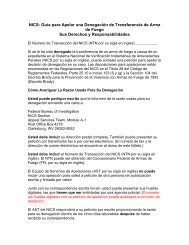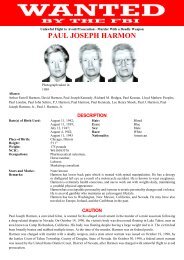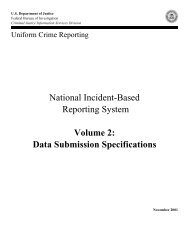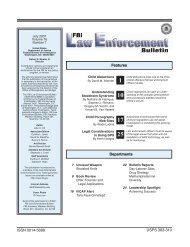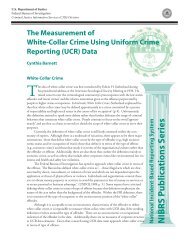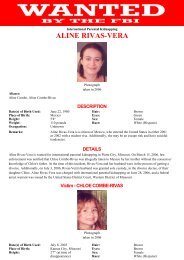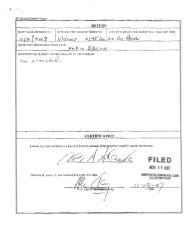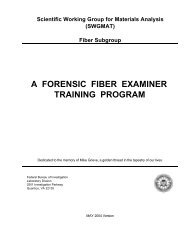F B I Law Enforcement Bulletin - June 2003 Issue
F B I Law Enforcement Bulletin - June 2003 Issue
F B I Law Enforcement Bulletin - June 2003 Issue
You also want an ePaper? Increase the reach of your titles
YUMPU automatically turns print PDFs into web optimized ePapers that Google loves.
2 / FBI <strong>Law</strong> <strong>Enforcement</strong> <strong>Bulletin</strong><br />
“ ...a tremendous<br />
change has<br />
occurred in the<br />
way ViCAP now<br />
provides services<br />
to state and local<br />
law enforcement.<br />
”<br />
Mr. Witzig, a former detective in the Homicide Branch of the Washington, D.C.,<br />
Metropolitan Police Department and agent of the chief medical examiner for<br />
Washington, D.C., is a major case specialist with the FBI’s Violent Criminal<br />
Apprehension Program.<br />
models. Their bodies, tied with rope<br />
in such a fashion as to suggest that<br />
the killer might practice bondage,<br />
subsequently were found in the<br />
desert.<br />
Mr. Brooks, convinced that<br />
these were not the killer’s first murders<br />
and that the offender would<br />
kill again, devised an early form<br />
of ViCAP. For 18 months, he used<br />
his off-duty time to visit the Los<br />
Angeles central library and read<br />
out-of-town newspapers to look for<br />
information on murders that exhibited<br />
characteristics similar to those<br />
he was investigating. He found such<br />
an article in a newspaper and, using<br />
pieces from that case coupled with<br />
evidence from his own cases, arrested<br />
an individual who subsequently<br />
was tried, convicted, and<br />
executed for the murders.<br />
Mr. Brooks refined his idea<br />
and concluded that a computer<br />
could capture relevant information<br />
about murders. If open and closed<br />
cases were stored in the computer,<br />
investigators easily could query the<br />
database for similar ones when they<br />
first confront new, “mystery” cases.<br />
They could use clues from other<br />
cases that exhibit similar characteristics<br />
to solve more cases. Moreover,<br />
when officers identify offenders,<br />
a search of the computer using<br />
their modus operandi (MO) would<br />
reveal other open cases for which<br />
they might be responsible. 3<br />
In 1983, the Office of Juvenile<br />
Justice and Delinquency Prevention<br />
and the National Institute of Justice<br />
gave a planning grant, the “National<br />
Missing/Abducted Children and<br />
Serial Murder Tracking and Prevention<br />
Program,” to Sam Houston<br />
State University in Huntsville,<br />
Texas. After three workshops, with<br />
the last held in November 1983, the<br />
National Center for the Analysis of<br />
Violent Crime (NCAVC) emerged.<br />
The U.S. Department of Justice provided<br />
the initial funding for the<br />
NCAVC and stipulated that it<br />
would be “...under the direction and<br />
control of the FBI training center at<br />
Quantico, Virginia.” 4<br />
ViCAP became a part of the<br />
NCAVC with its goal to “...collect,<br />
collate, and analyze all aspects of<br />
the investigation of similar-pattern,<br />
multiple murders, on a nationwide<br />
basis, regardless of the location or<br />
number of police agencies involved.”<br />
5 Mr. Brooks envisioned<br />
ViCAP as a “nationwide clearinghouse...to<br />
provide all law enforcement<br />
agencies reporting similarpattern<br />
violent crimes with the<br />
information necessary to initiate a<br />
coordinated multiagency investigation.”<br />
6 ViCAP attempts to identify<br />
similar characteristics that<br />
may exist in a series of unsolved<br />
murders and provide all police<br />
agencies reporting similar patterns<br />
with information necessary to initiate<br />
a coordinated multiagency<br />
investigation. 7<br />
REDESIGN OF VICAP<br />
Since ViCAP’s beginning at the<br />
FBI Academy in July 1985, its goal<br />
of identifying cases exhibiting similar<br />
characteristics and providing<br />
that information to law enforcement<br />
agencies for a coordinated, caseclosing<br />
investigation has remained<br />
constant. But, a tremendous change<br />
has occurred in the way ViCAP<br />
now provides services to state and<br />
local law enforcement. In 1996, a<br />
business analysis revealed several<br />
details about ViCAP. 8<br />
• Only 3 to 7 percent of the total<br />
cases were reported each year.<br />
Of the 21,000 homicides<br />
(average) reported per year in<br />
the 1990s, 9 only about 1,500<br />
to 1,800 were submitted to<br />
the nationwide database.




